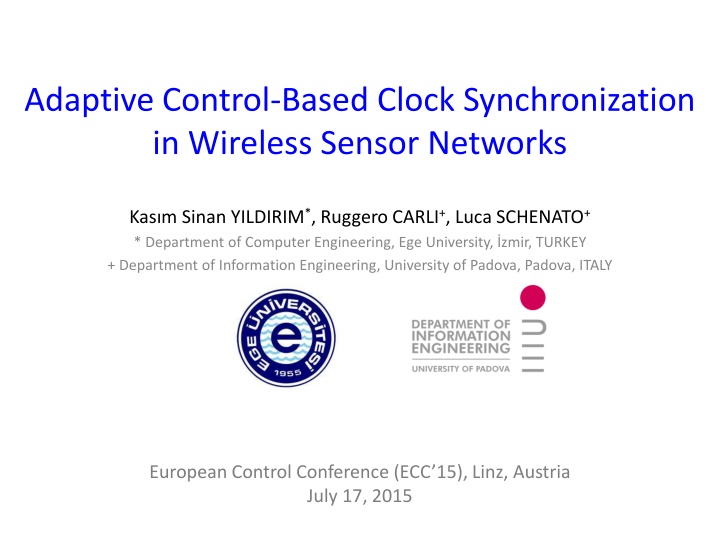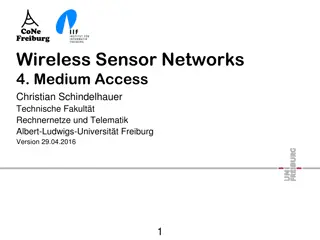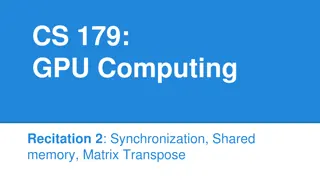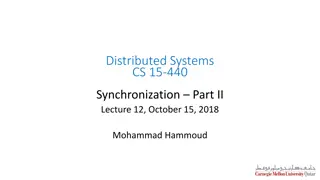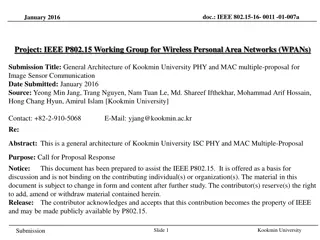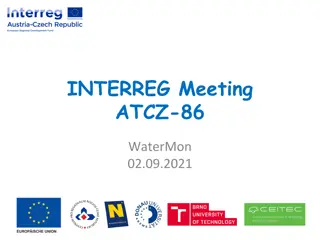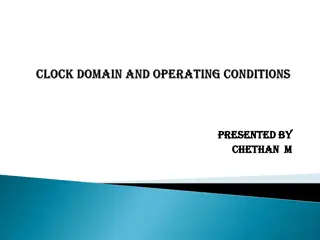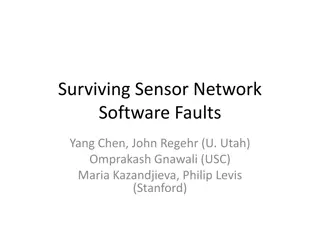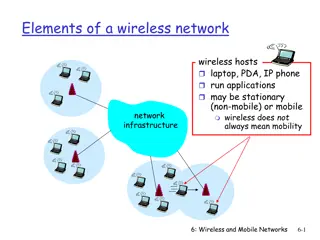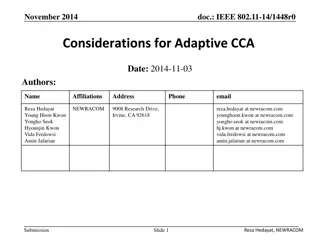Adaptive Control-Based Clock Synchronization in Wireless Sensor Networks
This study focuses on the implementation of adaptive control-based clock synchronization in wireless sensor networks to achieve precise time coordination among sensor nodes. It discusses the challenges, proposed solutions, hardware clock details, need for synchronization, and time synchronization mechanisms in WSNs. The content delves into pairwise synchronization techniques in practice, emphasizing master-slave synchronization and least-squares regression. Overall, the research aims to enhance the efficiency and accuracy of time synchronization in WSNs.
Download Presentation

Please find below an Image/Link to download the presentation.
The content on the website is provided AS IS for your information and personal use only. It may not be sold, licensed, or shared on other websites without obtaining consent from the author.If you encounter any issues during the download, it is possible that the publisher has removed the file from their server.
You are allowed to download the files provided on this website for personal or commercial use, subject to the condition that they are used lawfully. All files are the property of their respective owners.
The content on the website is provided AS IS for your information and personal use only. It may not be sold, licensed, or shared on other websites without obtaining consent from the author.
E N D
Presentation Transcript
Adaptive Control-Based Clock Synchronization in Wireless Sensor Networks Kas m Sinan YILDIRIM*, Ruggero CARLI+, Luca SCHENATO+ * Department of Computer Engineering, Ege University, zmir, TURKEY + Department of Information Engineering, University of Padova, Padova, ITALY European Control Conference (ECC 15), Linz, Austria July 17, 2015
Outline Wireless Sensor Networks Experiment s Need for Synchronization Control Theory Average Consensus & Discussion Existing Solutions Challenges Proposed Solution The Problem Results Adaptive Control-Based Clock Synchronization in WSNs 2
Wireless Sensor Networks Hardware clock (built-in clock) Counter register Clocked with external crystal 32kHz, 7.37 MHz nominal rate Read-only Clock drift Deviation from the nominal rate 30-100 parts per million (ppm) dependent on environmental factors such as: temperature, power supply, aging... [Sommer et al. 2009] Adaptive Control-Based Clock Synchronization in WSNs 3
Need for Synchronization Assigning global timestamps sensed data and events Coordinated actions Duty-cycling of the nodes for energy efficient operation Low-power, TDMA-based MAC layer Applications Localization via time-of-flight measurements Tracking of moving objects Adaptive Control-Based Clock Synchronization in WSNs 4
Time Synchronization Communicate Exchange current time information periodically Hardware clock value Compute Calculate a logical clock Software function represents the global time Challenge Measurement errors Message delay Deterministic and non-deterministic components Frequency t Expected delay Jitter 1-10 ms 0-100 ms 0-500 ms Send Access Transmission Reception Receive 0-100 ms t Adaptive Control-Based Clock Synchronization in WSNs 5
Pairwise Synchronization in Practice Master Slave Synchronization Collect (Hu,Hr) timestamp pairs periodically Employ least-squares regression Hr Reference Node r Slave Node u Linear relationship: Hr(t)= + Hu(t) clock offset Hu relative clock rate Beacon interval B Adaptive Control-Based Clock Synchronization in WSNs 6
Least-Squares with Two Pairs Measurement errors Slope: Measurement errors Error contributed by the transmission delays Error contributed by the transmission delays Poor multi-hop performance scalability Measurement errors Measurement errors Intercept: Errors enter non-linearly to the equations! The effect of various error sources appear as multiplicative noise! Adaptive Control-Based Clock Synchronization in WSNs 7
Time Synchronization as a Control Problem e(t+B) input Speed difference e(t) time Adaptive Control-Based Clock Synchronization in WSNs 8
Proportional Control steady state error P control instants Compensates only initial offset differences Adaptive Control-Based Clock Synchronization in WSNs 9
Proportional-Integral Control PI control instants Compensates both offset and clock speed differences Adaptive Control-Based Clock Synchronization in WSNs 10
PISync Algorithm - Pairwise Synchronization Reference Clock Estimate Offse t Speed Local time passed since update No need to store received timestamps! No regression table! Very simple arithmetic operations! Update Rule Receive<Hr(tup)> at time tup from r Calculate Error Update Offset Update Speed Convergence Conditions Optimal Convergence Rate Not the smallest steady-state error! Integral gain should be adjusted adaptively! Adaptive Control-Based Clock Synchronization in WSNs 11
PISync Algorithm Error Dynamics For kP=1, PISync algorithm becomes Error contributed by the transmission delays Error contributed by the transmission delays Measurement errors Measurement errors Scalable multi-hop performance Errors enter linearly to the equations! The effect of various error sources appear as additive noise! Adaptive Control-Based Clock Synchronization in WSNs 12
PISync - Integral Gain Adaptation As kI gets smaller, we obtain smaller steady-state error but longer convergence time! Maximum frequency error Adaptation Rule If e(h) > emaxthen kI = 0 (turn-off integrator) Else if kI = kI* Else if e(h)e(h-1)>0 then kI = max{2kI,kI*} Else kI = kI/3 successive error signs Gradually increase or decrease according to the Inspired from [Yildirim and Gurcan et al. 2014] Adaptive Control-Based Clock Synchronization in WSNs 13
PI control + Average Consensus Clocks from neighboring nodes PI No special reference node! Nodes synchronize directly to their neighbors! Adaptive Control-Based Clock Synchronization in WSNs 14
Testbed Testbed setup 20 MICAz sensor nodes FTSP (Flooding Time Synchronization Protocol [Marotti et al. 2004]) and PISync implemented in TinyOS 2.1 Network topology Line and grid topologies Parameters Communication frequency: B=30 seconds Regression table of size 8 for FTSP fnom= 1 MHz kP=1 and 0 < kI < 2/(Bfnom) Adaptive Control-Based Clock Synchronization in WSNs 15
FTSP vs PISync FTSP Completely blind operation! No need to store neighbors time information explicitly! Suitable for mobile networks! Robust to packet losses FTSP Very simple arithmetic operations No need to store time information explicitly! Scalable! FloodPISync AvgPISync Adaptive Control-Based Clock Synchronization in WSNs 16
PISync Complexity Very easy to implement & code 20 times better performance! 50 times fewer operations! 4 times less RAM requirements! Low power consumption! FTSP PISync 0.5 ms 20 microseconds Error FTSP 52 bytes 16 bytes RAM 18000 bytes 15432 bytes ROM 5.5 ms 145 microseconds CPU Just 15 Lines of TinyOS code! Adaptive Control-Based Clock Synchronization in WSNs 17
Conclusions We considered time synchronization as a control problem We solved this problem with a very simple and practical technique Proportional-Integral Controller We introduced a new time synchronization protocol PISync We observed Better performance scalability Less resource consumption Lower CPU and main memory overhead Lower power consumption Adaptive Control-Based Clock Synchronization in WSNs 18
Future Research Directions Performance evaluation on real mobile networks Implementation & evaluation of time-synchronized MAC layer Adaptive receiving window Evaluation of power consumption Other algorithmic techniques? Better steady-state error & convergence Even lower resource requirements? Adaptive Control-Based Clock Synchronization in WSNs 19
THANK YOU! ANY QUESTIONS? Adaptive Control-Based Clock Synchronization in WSNs 20
